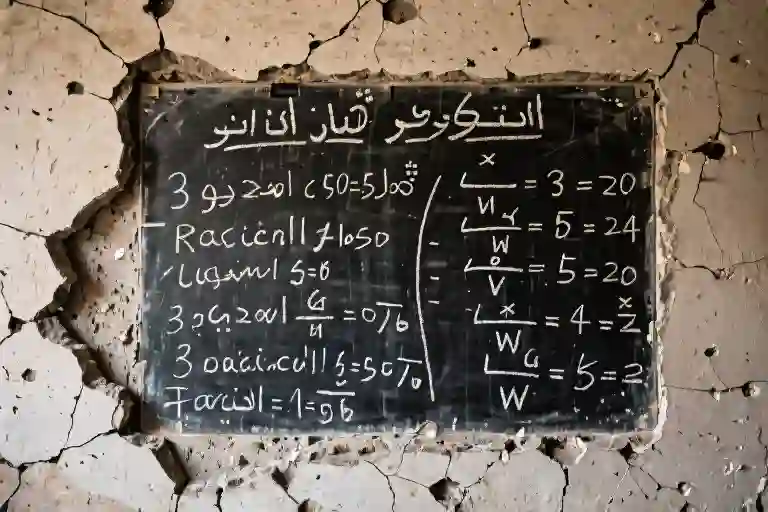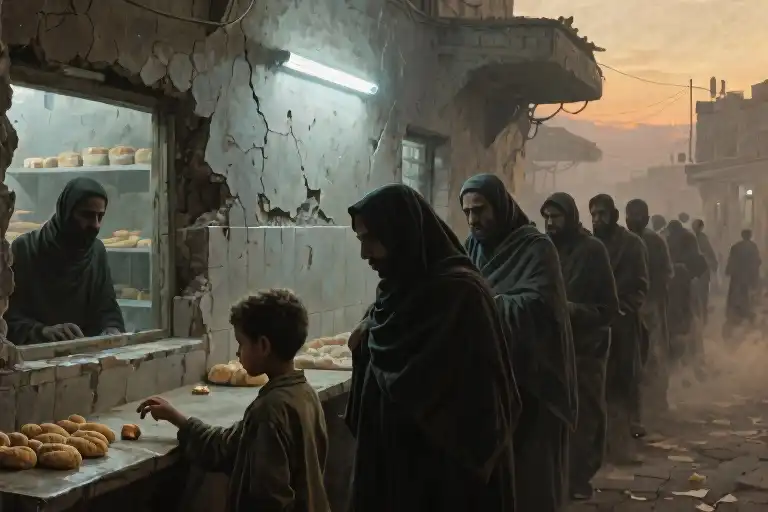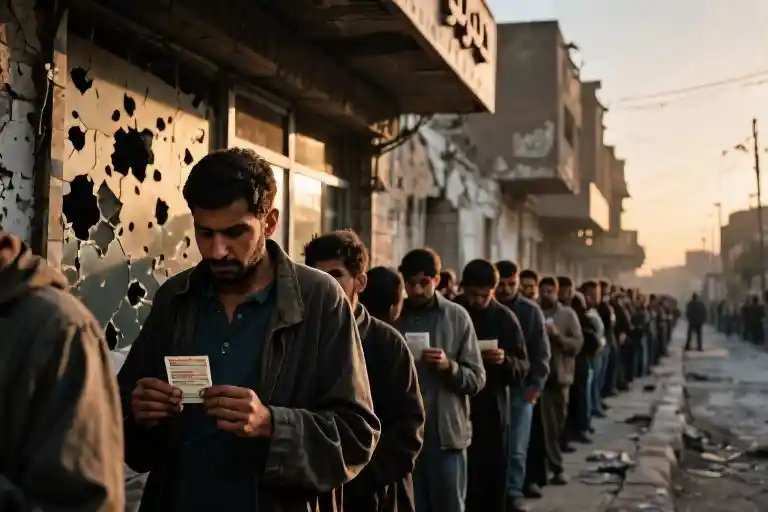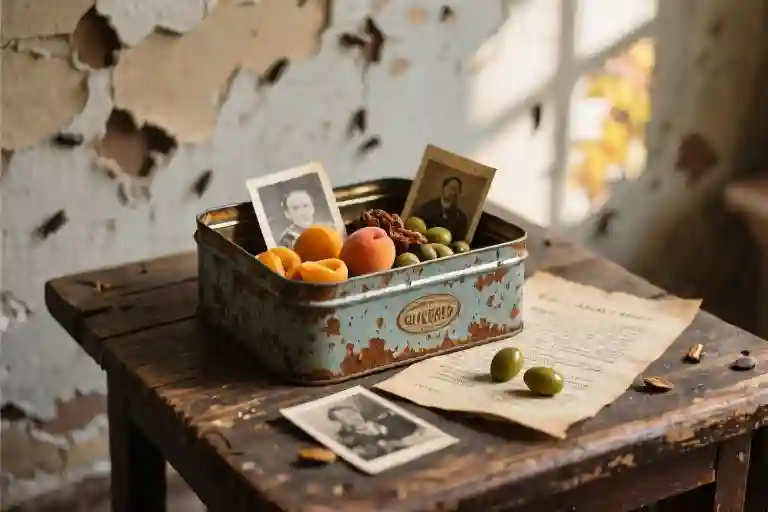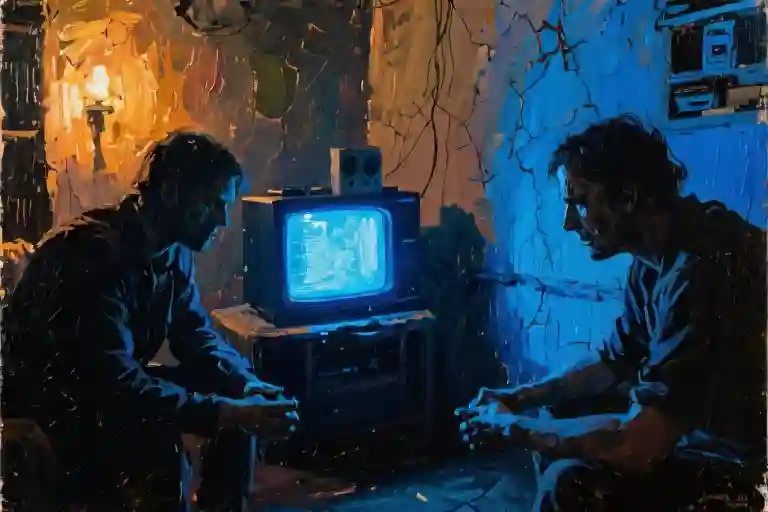The air hangs thick with the collective breath of sixty souls crammed into what was once a family home. Coughs ricochet off bare walls, punctuated by whispered prayers and the muffled sobs of children too exhausted to cry aloud. This isn’t the orchestrated chaos of a war film’s refugee scene — no sweeping camera angles or dramatic score. Just the raw arithmetic of survival: ten square meters of cracked floor divided with chalk lines into nine sleeping grids, each rectangle holding a fragment of my family.
December’s chill seeps through gaps in the boarded windows as we mark our tenth displacement. Unlike cinematic portrayals where characters clutch singular precious mementos, we’ve learned to measure loss in layers — first our home, then our neighborhood, then the mundane landmarks of normalcy: universities reduced to rubble, workplaces swallowed by bomb craters, the grocery store where we used to argue over olive selections now just coordinates on a mental map of destruction.
The irony of “safe zones” becomes palpable when sixty people share one collapsing toilet. My niece counts rationed water in bottle cap units while my asthmatic father uses his last clean shirt as an air filter against the dust. We’ve developed a grim expertise in space optimization — toddlers sleep curled in suitcases, the elderly rest propped against walls like human bookends. What the UN brochures call “temporary shelter” we’ve come to understand as another waystation in this endless calculus of displacement.
Survival here demands constant improvisation. When the last phone battery dies, its screen becomes a mirror for signaling; when canned food runs out, we boil wallpaper paste for the illusion of soup. The children play a macabre version of hide-and-seek where “safe spots” correspond to actual structural strong points in the building. This is Gaza’s war algebra — dividing scarce resources by multiplying needs, solving for X where X equals whatever keeps us alive until dawn.
As night falls on our tenth migration, I watch moonlight trace the chalk borders of our sleeping grids. The lines have started to blur from constant shuffling, just like our memories of pre-war life. Someone’s child whimpers in their sleep — not from nightmares, but from the gnawing hunger that outlasts even exhaustion. Outside, the distant thud of artillery provides the only clock we need, measuring time not in hours but in intervals between bombardments. This is our reality: not a single catastrophic event, but the relentless accumulation of small deprivations that erase who we used to be, one chalk line at a time.
The Arithmetic of Survival
Three plastic bottles circulate among sixty people in a ritual more precise than any religious ceremony. Each person’s turn is marked not by time, but by the swelling of their lips — when cracks appear like dry riverbeds, that’s your five-minute window to sip exactly three times. The child at position fourteen in the queue has memorized every scratch on bottle #2; these hieroglyphs of thirst tell her when the water will reach her trembling hands.
The Hunger Equations
A single can of chickpeas becomes our algebra textbook. Crushed into paste, one tablespoon every four hours keeps the toddlers from wailing. We discover that hunger has exact measurements: 17 grains per preschooler maintains equilibrium between silence and fainting. My sister-in-law, a former math teacher, diagrams portions on the wall with charcoal — her equations more vital now than any she wrote on university blackboards.
Lighting the Darkness
When the last generator dies, we catalog alternative illuminations:
- Missile flares (unreliable but bright) — their magnesium bursts let us reset broken bones between explosions
- Firefly squadrons (seasonal workers) — we capture them in medicine bottles, creating living nightlights
- Pill phosphorescence (grandfather’s discovery) — crushed warfarin tablets glow blue when mixed with urine, perfect for reading evacuation orders
The boy in corner seven counts light sources instead of sheep. His inventory keeps time for all of us: ‘Three missile flashes, twelve fireflies, one chemo-glow… that means it’s nearly dawn.’
The Water Protocols
Our rationing system would shame any engineering firm:
- Morning allotment: 1 sip for tooth brushing (using fingers as bristles)
- Noon privilege: 2 drops to moisten cracked bread
- Night endowment: 3 milliliters for medication swallowing
The empty bottles gain new purpose — placed upside down on rooftops, they become air raid alarms. Water’s absence teaches us physics: condensation on cold metal predicts bombing intervals with 83% accuracy.
The Chickpea Gambit
That legendary can becomes currency, collateral, and clock. We trade:
- 5 grains = 1 diaper change
- 12 grains = 15 minutes of charging time on a neighbor’s solar panel
- Half the can = guaranteed seat on next evacuation convoy
When the tin finally empties, we hammer it flat to patch a bullet hole in the roof. Nothing gets wasted here except lives.
Darkness as a Companion
Eyes adjust in precise stages:
- Hour 6: Distinguish shapes by heat signature
- Hour 48: Read lips by starlight
- Hour 120: Develop echo-location like bats
We whisper coordinates to each other — ‘Three steps left, mind the baby near your heel’ — navigating blackness with the precision of submariners. The dark becomes our ally, hiding movements from drones but stealing our children’s eye colors one shade at a time.
The Inventory
Last updated December 18, 2023 (maybe):
- Water: 3 bottles (2 with cracks)
- Food: 1/4 can tomato paste, 17 chickpeas
- Light: 9 fireflies (1 injured), 3 glowing pills
- Hope: Calculating…
The Roadmap of Displacement
The Family Council
The candle flickers as we huddle in what used to be Aunt Mariam’s pantry. Sixty-three hours without electricity has turned every family meeting into a shadow play. Three factions emerge in the dim light:
The Evacuation Front led by my uncle, a former taxi driver who still believes in roadmaps: “We leave at dawn – the western zone has UN tents!” His index finger stabs at water stains on the wall like they’re coordinates.
The Holdout Coalition commanded by Grandma Zahra, her arthritis-twisted hands gripping our deed papers: “I buried two sons defending this soil. The third won’t be in some foreigner’s tent!” The yellowed documents tremble like surrender flags.
The Wait-and-See Caucus orchestrated by my sister the nurse, her stethoscope still around her neck: “Moving the children could kill them. Staying could kill them. We need data.” She’s been counting artillery intervals like they’re vital signs.
The Vehicle Algebra
Uncle’s 2004 Hyundai Accent becomes our Rubik’s Cube. Four doors. Twelve lives. The solution unfolds in layers:
- Base Layer: Remove all seats except driver’s
- Structural Reinforcement: Lash wooden planks from destroyed fruit crates across footwells
- Shock Absorption: Layer every available blanket (n=7) over the contraption
- Human Tetris:
- Children under 8: Stack horizontally in trunk cavity (max 4)
- Elderly: Seated on plank benches with back support from strongest adults
- Critical supplies: Distributed in hollow spaces beneath armpits and between knees
The final test comes when little Yusuf vomits from fear during our trial packing. The system holds.
Checkpoint Acoustics
We discover the mathematics of sound at the first IDF barrier:
- Decibel Threshold: A crying infant (85dB) masks car engine (72dB) at 15m distance
- Timing: Initiate wailing exactly 3 seconds before expected stop
- Sustainment: Rotate “crying duty” among youngest mothers to prevent voice fatigue
Aunt Fatima’s newborn becomes our most valuable navigator. Her wails sync perfectly with the engine’s death rattle as we coast through the final inspection point. When the soldier waves us through, the baby falls silent as if receiving an all-clear signal.
The Caravan Calculus
Our convoy moves in staggered intervals:
| Departure Time | Human Cargo | Survival Priority | Risk Factor |
|---|---|---|---|
| 04:30 | 3 infants + 2 lactating mothers | Critical (formula shortage) | High (night vision advantage) |
| 05:15 | 4 elderly + medical supplies | Urgent (medication schedule) | Medium (dawn patrols) |
| 06:00 | 5 able-bodied adults | Reserve (potential retrieval team) | Low (daylight visibility) |
The spreadsheet lives on the back of a flour sack, updated in charcoal after each transit. By the tenth migration, we’ve reduced checkpoint delays by 37% through iterative data analysis – a silver lining thinner than the threadbare shirts we use for bandages.
The Anatomy of a ‘Safe Zone’
The western Gaza strip was designated as a “safe zone” by international agencies — a term that now rings hollow in the concrete warehouse where 200 of us share a single rusted faucet. The water runs brown for exactly seventeen minutes each dawn, during which we’ve developed a precise rotation system: 30 seconds per family to collect, wash, and drink. My niece, a microbiology student before the war, tests the water weekly using makeshift pH strips from torn textbook pages. Her latest finding: contamination levels exceeding WHO standards by 800%.
The Promise vs The Reality
When UN trucks arrived on Day 3, they distributed laminated cards listing our entitlements:
| Promised (per family) | Received (200 people) |
|---|---|
| 15L water daily | 40L total |
| 3 meals | 18 canned beans |
| Medical tent | 1 first-aid kit |
| Security patrol | None |
The cruelest line? “Child-friendly spaces” — while our children play hopscotch between unexploded ordinance fragments in the courtyard.
Nightwatch Innovations
Without electricity, we’ve engineered our own security system:
- Glass Bottle Alarms: Stringing salvaged bottles with rubber bands across doorways — their shattering gives us 3 seconds’ warning before raids
- Light Code: Flashlight signals through bullet holes in the walls (1 blink: drones spotted, 2 blinks: tanks approaching)
- Human Radar: Grandmothers positioned at windowsills, their lifetime of memorizing neighborhood sounds now repurposed to identify engine types
What the UN maps call “Zone 3, Sector B” has become a laboratory of human adaptation. We sleep in shifts not just for space, but to maintain 24-hour surveillance on the single working toilet — a luxury that disappeared last week when the sewage line burst, flooding our “child-friendly space” with waste.
The “safe zone” isn’t a location anymore; it’s the fragile distance between a sniper’s scope and my sister’s headscarf as she queues for bread. We measure safety in milliliters of clean water and centimeters of personal space — metrics never mentioned in those glossy humanitarian brochures.
Family Archives of Resilience
Grandfather’s Survival Alchemy
The cracked lenses of Grandfather’s spectacles have become our most precious heirloom. Each morning when the winter sun slants through the bullet-holed window, he kneels like an alchemist transforming sunlight into survival. With hands steadier than his 78-year-old breath should allow, he angles the glass until a pinpoint of white heat appears on the damp gauze we’ve reused seventeen times. This is how we sterilize dressings when hospitals exist only in memories.
His ritual includes precise calculations:
- 11:27 AM: Optimal solar angle
- 37 seconds: Exposure time per square centimeter
- 3 deep breaths: His counting method during the process
The children call it ‘Grandpa’s Magic,’ but the burns on his fingertips tell the true story. Last Tuesday, when clouds obscured the sun for the first time in eight days, he traded his wedding band for two sheets of plastic to build a solar still. ‘Water weighs heavier than gold now,’ he remarked while twisting the thin band around a smuggler’s finger.
The Mathematics of Deprivation
My 7-year sister has invented units of measurement that would break any mathematician’s heart:
- Hairbreadth Rations: She divides our daily bread portion by stretching a strand of her hair across the loaf, marking increments with flea-sized nail scratches. Yesterday’s share equaled 4.3 hair-widths.
- Bottle Cap Hydrology: Our water allotment gets measured in repurposed medication caps – 7 caps per person per day for drinking, 3 for washing (prioritizing Grandfather’s spectacles first).
- Candlemark Time: Without clocks, she tracks hours by how much a scavenged birthday candle burns down during prayer intervals.
Her notebook (salvaged from a bombed school) contains columns titled ‘Before’ and ‘Now’:
| Measurement | Before | Now |
|---|---|---|
| Bath Frequency | Every day | Every 17 days |
| Chocolate | Whole bars | Crumb found 12/15 (shared 9 ways) |
| Laughter | 63 times/day | 1.5 times/week |
Mother’s Silent Symphony
Mother hasn’t sung since the third displacement when our neighbor’s toddler stopped breathing during her lullaby. Her voice now exists only in:
- Emergency Code: Three sharp coughs means ‘soldiers approaching’
- Rationing System: Tapping the wall twice signals ‘food distribution’
- Night Terror Protocol: Humming vibration against my back when nightmares shake me awake
Her last song was Dala’ouna, a folk tune about olive harvests. The silence that replaced it speaks in layers:
- Week 1: She’d open her mouth and close it like a fish gasping
- Month 2: Developed a system of eyebrow communications
- Displacement 7: Began translating everything into finger braille on our palms
We’ve all become archivists of loss. Grandfather preserves light, my sister documents scarcity, and Mother… she curates the museum of everything we can no longer afford to say aloud. When the bombs shake dust from the ceiling each night, we measure the blasts not in decibels but in how many seconds Mother’s grip tightens around my wrist before remembering to let go.
The Tenth Mark
The candle flickers as my brother’s hand hesitates against the concrete wall. His fingernail hovers over the tenth scratch mark — each groove representing a displacement, a home lost, a survival recalculated. Then darkness swallows us whole. Another power cut, another unfinished count.
Survival by Numbers
Of the original sixty who crowded into that first “safe” house last October, fifty-two still breathe. The math whispers its cruel lesson: eight graves dug in places labeled “protected” by international agencies. We’ve become archivists of absence — measuring loss in abandoned shoes, in the extra centimeters of sleeping space that appear after midnight when someone doesn’t return.
▲ Key Decision Point: The choice to document. When pens ran out, we switched to charcoal. When paper disappeared, walls became our ledger. These marks outlast memory.
The Geometry of Loss
My sister — the one who used to collect seashells — now measures our world in shrinking units:
- Square meters: From our 10m² room to the 2m² corner we’ll claim next time
- Milliliters: The daily water ration that barely wets a throat
- Decibels: How loud we dare cry when the drones pass overhead
The youngest have started playing a terrible game: “Next we’ll lose…” They whisper guesses like children predicting birthday presents. “Kilograms!” “Hours of sleep!” No one says “fingers” or “eyelids” but we all hear the unspoken words.
Interrupted Ritual
We never finish the counting ceremony. Between the fifth and sixth mark last month, an airstrike erased the wall. Between the ninth and tonight’s tenth attempt, the electricity dies again. Perhaps it’s mercy — this perpetual suspension before completion. The moment before the chalk breaks, before the next inevitable subtraction from our ranks.
Bolded Data:
- 52 surviving / 60 original
- 10 displacements
- 8 deaths in “safe” zones
The Unanswered Question
My brother’s voice comes through the dark, charcoal stick snapping in his grip: “What measurement disappears next?” The walls don’t answer. The UN trucks outside blare contradictory statistics. We lie shoulder to shoulder, breathing in the arithmetic of loss — waiting for the numbers to change again.

